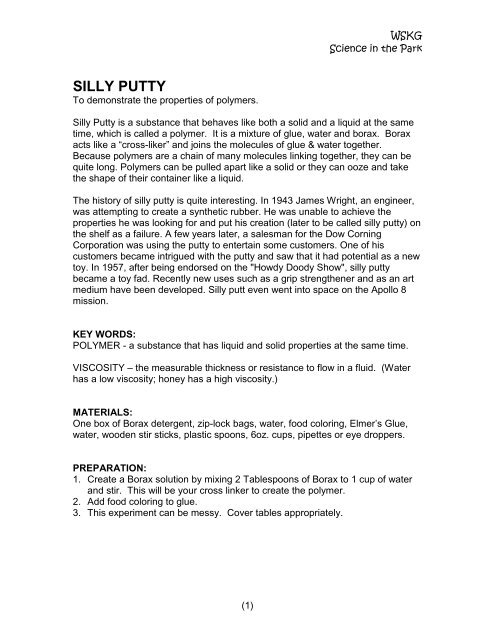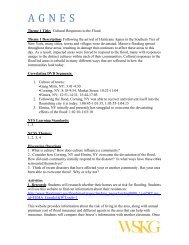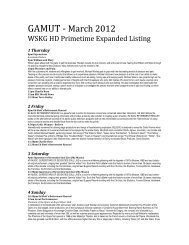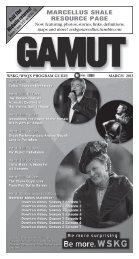Create successful ePaper yourself
Turn your PDF publications into a flip-book with our unique Google optimized e-Paper software.
<strong>WSKG</strong><br />
Science in the Park<br />
<strong>SILLY</strong> <strong>PUTTY</strong><br />
To demonstrate the properties of polymers.<br />
Silly Putty is a substance that behaves like both a solid and a liquid at the same<br />
time, which is called a polymer. It is a mixture of glue, water and borax. Borax<br />
acts like a “cross-liker” and joins the molecules of glue & water together.<br />
Because polymers are a chain of many molecules linking together, they can be<br />
quite long. Polymers can be pulled apart like a solid or they can ooze and take<br />
the shape of their container like a liquid.<br />
The history of silly putty is quite interesting. In 1943 James Wright, an engineer,<br />
was attempting to create a synthetic rubber. He was unable to achieve the<br />
properties he was looking for and put his creation (later to be called silly putty) on<br />
the shelf as a failure. A few years later, a salesman for the Dow Corning<br />
Corporation was using the putty to entertain some customers. One of his<br />
customers became intrigued with the putty and saw that it had potential as a new<br />
toy. In 1957, after being endorsed on the "Howdy Doody Show", silly putty<br />
became a toy fad. Recently new uses such as a grip strengthener and as an art<br />
medium have been developed. Silly putt even went into space on the Apollo 8<br />
mission.<br />
KEY WORDS:<br />
POLYMER - a substance that has liquid and solid properties at the same time.<br />
VISCOSITY – the measurable thickness or resistance to flow in a fluid. (Water<br />
has a low viscosity; honey has a high viscosity.)<br />
MATERIALS:<br />
One box of Borax detergent, zip-lock bags, water, food coloring, Elmer’s Glue,<br />
water, wooden stir sticks, plastic spoons, 6oz. cups, pipettes or eye droppers.<br />
PREPARATION:<br />
1. Create a Borax solution by mixing 2 Tablespoons of Borax to 1 cup of water<br />
and stir. This will be your cross linker to create the polymer.<br />
2. Add food coloring to glue.<br />
3. This experiment can be messy. Cover tables appropriately.<br />
(1)
<strong>WSKG</strong><br />
Science in the Park<br />
DIRECTIONS:<br />
1. Give each student a zip-lock bag, wooden stir stick, cup and assist them<br />
with the following steps:<br />
2. Have students measure 2 tsp of glue and 2 tsp of water into their cups.<br />
3. Stir glue/water mixture.<br />
4. Add Borax solution to glue/water mixture 5 drops at a time.<br />
5. Stir mixture. The mixture should start creating a visible polymer on the<br />
end of the stir stick. Continue adding Borax solution in small amounts until<br />
all liquid disappears in your cup. Do not add too much cross linker<br />
solution or the reaction will not work.<br />
6. Have students take the polymer out of the cup and touch it. They should<br />
roll the mixture around in their hands, first slowly and then quickly.<br />
7. Have students place the polymer on the table, what happens? It should<br />
ooze like a liquid. Have students pull the polymer apart and it will break<br />
apart like a solid.<br />
8. Store in Ziploc bag (which is also a polymer).<br />
RESULTS:<br />
The polymers in silly putty have covalent bonds within the molecules, but<br />
hydrogen bonds between the molecules. The hydrogen bonds are easily broken.<br />
When small amounts of stress are slowly applied to the putty, only a few bonds<br />
are broken and the putty "flows". When larger amounts of stress are applied<br />
quickly, there are many hydrogen bonds that break, causing the putty to break or<br />
tear. Examples of polymers are plastics, such as plastic bags, rubber, synthetic<br />
fabrics in some shirts and pants, keyboard and computer casings, Ipods, cell<br />
phone covers, glasses (including lenses if they are not glass)<br />
QUESTIONS:<br />
How can it be solid and liquid at the same time?<br />
Is a polymer more than one molecule? (hint: name the ingredients<br />
used for the experiment)<br />
Why isn’t your hand wet after you let the mixture slide through your<br />
fingers?<br />
**Important note! Do NOT pour Silly Putty down the drain<br />
It will<br />
clog the pipes. Dispose of the mixture in the zipper lock bag in the<br />
garbage!<br />
(2)









